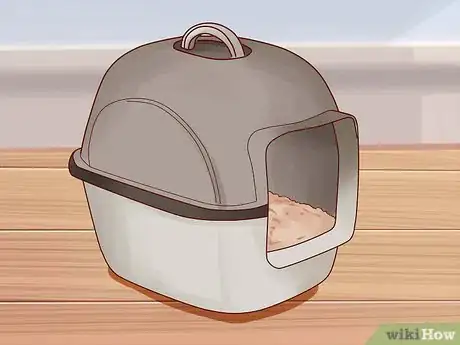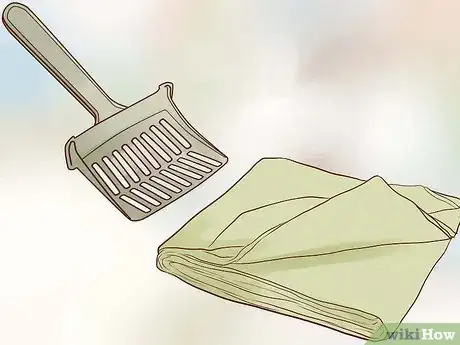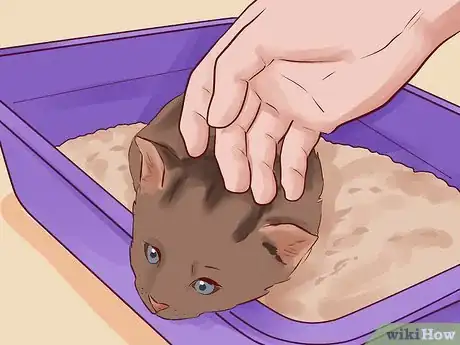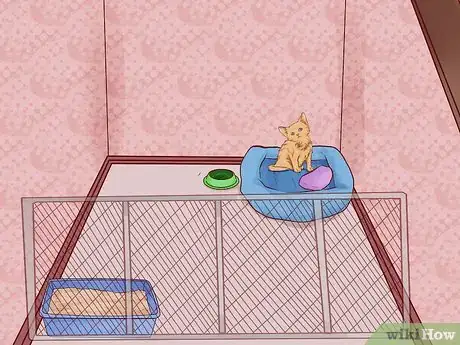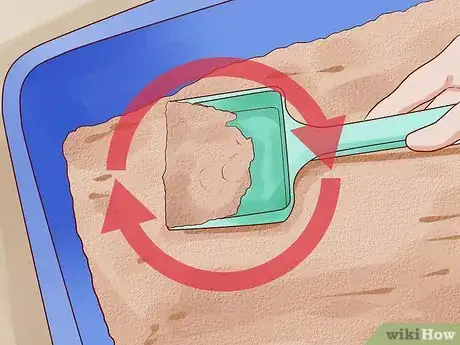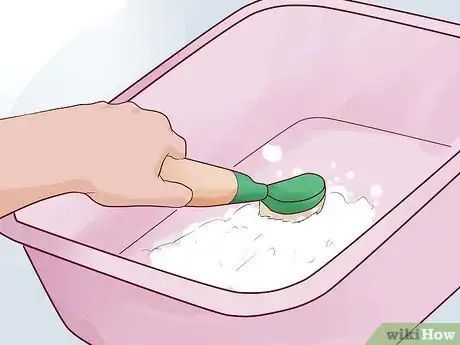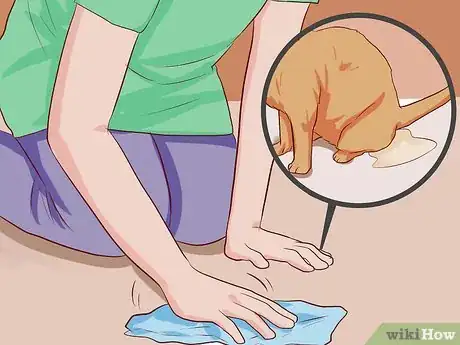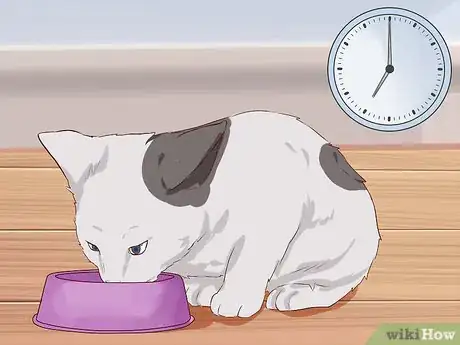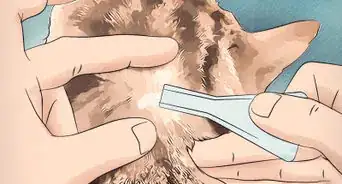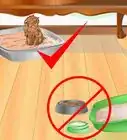This article was co-authored by Pippa Elliott, MRCVS. Dr. Elliott, BVMS, MRCVS is a veterinarian with over 30 years of experience in veterinary surgery and companion animal practice. She graduated from the University of Glasgow in 1987 with a degree in veterinary medicine and surgery. She has worked at the same animal clinic in her hometown for over 20 years.
There are 7 references cited in this article, which can be found at the bottom of the page.
wikiHow marks an article as reader-approved once it receives enough positive feedback. This article received 19 testimonials and 88% of readers who voted found it helpful, earning it our reader-approved status.
This article has been viewed 1,596,332 times.
Kittens naturally like to relieve themselves in dirt or sand. If you introduce them to a litter box, they'll gladly go there instead of on your carpet. If you start as soon as you bring your kitten home, he or she will be using the box regularly in no time. It is important to find the right box for your kitten and encourage her to use it, but you won’t need to "litter train" a cat in the same way you would house-train a dog. You shouldn’t need to teach your cat what to do with a litter box; instinct will generally take over. You do need to provide an acceptable, accessible litter box.[1]
Steps
Purchasing Supplies
-
1Select a large litter box. Small boxes are available for tiny kittens, but kittens grow up so fast that you'll have to replace the litter box soon after introducing it. When you replace a litter box you have to retrain the kitten, so it's better to start with a box you plan to use for a long time.
- Kittens have no trouble getting into large litter boxes, as long as one side is low enough that they can step inside. If you find a great box but aren't sure whether the kitten will be able to climb inside, use a piece of plywood or another flat material with good traction to make a little ramp. Affix it to the side of the litter box using duct tape, and remove it when the kitten has grown big enough to get inside without it.
-
2Consider an enclosed litter box. Some litter boxes have an enclosure (or top) around them. The advantage of the enclosed litter box is that it can contain the litter for an enthusiastic kicker/digger and it may cut down smells if you have the box in a small living area. Some cats also feel protected by the enclosure.[2]
- Be sure that the enclosed litter box is large; cats need enough room to comfortably turn around inside the box. Most cats have a behavioral need to sniff their feces and then bury them, and the box needs to allow plenty of room for that.[3]
- Some cats do not like enclosed boxes when initially introduced to them. You can ease the transition by removing the swinging door until your cat becomes acclimated to the box.
Advertisement -
3Buy kitty litter. There are many types of litter to chose from, and most types litter are fine for most juvenile or adult cats (8 months or older.) Select a litter that is as dust-free as possible, since dust can irritate cats’ lungs.[4] You might want to keep the following factors in mind as you make your choice:
- Do not use clumping cat litter for kittens. If they eat it (which they do) it sticks together in their gut and can cause a serious impaction.
- Use unscented litter if possible. Kittens and cats may not like perfumed litter; if the scent is overpowering, they may use bathroom somewhere else.[5] Additionally, some scents could irritate a cat’s nose and eyes or cause problems for cats who are prone to respiratory problems.
- Consider a scoopable litter. Scoopable litter has become a popular choice, since it makes removing the kitten's waste quite easy. Be aware that there is some concern that a cat could become sick from ingesting scoopable litter, but that there is little or no evidence of this happening.[6] [7]
- Select a litter that is widely available. Some cats become accustomed to a specific litter and may not recognize the tray as a toilet unless it contains their usual litter.
-
4Purchase a scooper and drop cloth. The last things you need to get ready for litter training your kitten are a scooper for removing waste from the litter box and a drop cloth to place under the box to prevent stray litter from soiling your house.
Introducing the Kitten to the Litter Box
-
1Place the box in a peaceful location. Don't put it in a high-traffic area of your home, like the kitchen or entry hall. The ideal litter box location is easily accessible, offers plenty of privacy, and is free from sudden noises that could frighten a kitten.[8]
- Though a laundry room is a popular choice for a location because it has less traffic than other areas of most houses, the sudden noises that a washer or dryer can make while switching cycles could frighten a kitten and cause her to fear using the box.[9]
- The litter box should be in an area that a kitten spends a lot of time. The kitten should be able to see the litter box most of the time so that she can use it if she needs to.
- Kittens and cats prefer a little privacy. If they don't have it, they may start relieving themselves behind the sofa or in another out-of-the-way corner.[10]
- If you start litter training a kitten and it becomes necessary to move the box, do it gradually, a few feet at a time every few days. Moving the box to a different room from one day to the next could confuse the kitten and lead to accidents around the house. It may also help to place the kitten’s food bowl where the litter box used to be, as most cats are reticent to use the toilet where they eat.
-
2Place the kitten in the filled litter box. As soon as you bring the kitten home, place her in the box so she can get used to the smell and feel of the kitty litter. Let her spend a few minutes there, even if she doesn't go to the bathroom the first time. Continue to place the kitten in the box after she eats meals, wakes up, or any other time when you predict she may need to relieve herself. In addition, if she squats anywhere other than the litter box place her in it immediately.
- Some kittens will understand the purpose of the litter box immediately and require no additional litter training. Others will need to be placed in the litter box as many as ten times a day before they figure it out.
- You should avoid attempting to "show" the kitten the digging motion that cats use to bury their waste as it may frighten them, so avoid the temptation to take her paws and help her dig into the litter until she catches on.[11]
-
3Use praise, not punishment. As the kitten grows used to the litter box and starts using it as her toilet, praise her each time she goes by petting her and making comforting sounds. Do not discipline her while she is in the box, or she might start associating being in the box with punishment.[12]
- Kittens do not respond well to having their noses rubbed in a mess they have made outside the litter box. If she has an accident, let her sniff the mess, then gently lift her and put her in the box, so she knows where to go next time.
- Never spank or yell at a kitten to punish her. It will only serve to make her afraid of you.
-
4Provide enough litter boxes. If possible, you should have one litter box for each cat in your house, plus an additional litter box.
- For example, one kitten should ideally have 2 litter box options. If you have three cats, you should provide four litter boxes.
-
5Consider a confinement period. When you first introduce a kitten to your home, you may want to confine her to a small area for the first few weeks. This can help her acclimate slowly to her new environment, will give her easy access to her litter box, and can help minimize or confine accident areas.[13]
- You may want to confine the kitten to an area without carpet to make accidents easier to clean if they do occur.
- Keep the litter box and the kitten’s food and bedding at opposite ends of the confinement area.[14]
Keeping Your Kitten Comfortable
-
1Clean the litter every day. Kittens do not like to relieve themselves in dirty areas. If you don't change the litter, the kitten may find a cleaner place, like the carpet, to do her business.
- To clean the litter box, scoop the waste out of the box, place it in a small baggie, close the bag, and throw it away.
- You can leave a small bit of feces in the litter box (changing it frequently) during the first few weeks. This helps the kitten recognize what the box is for.
-
2Clean the entire litter box frequently. About once a week, you will need to completely dump the contents of the litter pan and give it a thorough cleaning. Once the pan is emptied out, wash it with a non-hazardous cleaning solution (or warm soapy water), then rinse the pan, dry it, and refill it with clean litter.[15]
- It can be tempting to leave scoopable litter for longer than one week due to the ease of removing the cat’s waste. However, even scoopable litter needs to be completely emptied and replaced frequently.
-
3Clean accident areas thoroughly. If your kitten or cat uses the bathroom outside of the litter box, be sure that you completely clean the area, removing all traces of urine or feces. This should help reduce repeat accidents in the same area.[16]
-
4Consider removing large potted plants from your home. If you find that your kitten is using the dirt in your potted plants for a toilet, you may need to remove them or cover the dirt with foil during litter training. Kittens instinctively bury their waste, so they may be attracted to dirt or sandy areas. Make sure the litter box is the only place in the house where they want to relieve themselves.
-
5Feed the kitten at regular times. This will help you be able to predict when she will need to use the litter box. Kittens generally feel the urge to have a bowel movement about 20 minutes after eating. When you think she has the urge to go, take her to the box and let her climb inside.
Expert Q&A
Did you know you can get expert answers for this article?
Unlock expert answers by supporting wikiHow
-
QuestionIs it safe to train a one-week old kitten to use the litter tray?
 Pippa Elliott, MRCVSDr. Elliott, BVMS, MRCVS is a veterinarian with over 30 years of experience in veterinary surgery and companion animal practice. She graduated from the University of Glasgow in 1987 with a degree in veterinary medicine and surgery. She has worked at the same animal clinic in her hometown for over 20 years.
Pippa Elliott, MRCVSDr. Elliott, BVMS, MRCVS is a veterinarian with over 30 years of experience in veterinary surgery and companion animal practice. She graduated from the University of Glasgow in 1987 with a degree in veterinary medicine and surgery. She has worked at the same animal clinic in her hometown for over 20 years.
Veterinarian Very young kittens such as this are not able to empty their own bladder and bowel, but hold on and only toilet when stimulated to do so by their mother licking. Also, the kitten is not yet able to walk and is still blind so they won't be able to find their way to the tray and climb in. By all means have a litter tray set up for the kitten to use, so they can discover it as they become mobile, but a one-week old kitten still needs their toileting needs seen to by the mother.
Very young kittens such as this are not able to empty their own bladder and bowel, but hold on and only toilet when stimulated to do so by their mother licking. Also, the kitten is not yet able to walk and is still blind so they won't be able to find their way to the tray and climb in. By all means have a litter tray set up for the kitten to use, so they can discover it as they become mobile, but a one-week old kitten still needs their toileting needs seen to by the mother. -
QuestionWhy is my kitten eating the cat litter?
 Pippa Elliott, MRCVSDr. Elliott, BVMS, MRCVS is a veterinarian with over 30 years of experience in veterinary surgery and companion animal practice. She graduated from the University of Glasgow in 1987 with a degree in veterinary medicine and surgery. She has worked at the same animal clinic in her hometown for over 20 years.
Pippa Elliott, MRCVSDr. Elliott, BVMS, MRCVS is a veterinarian with over 30 years of experience in veterinary surgery and companion animal practice. She graduated from the University of Glasgow in 1987 with a degree in veterinary medicine and surgery. She has worked at the same animal clinic in her hometown for over 20 years.
Veterinarian
-
QuestionWhy is my kitten meowing at me?
 Pippa Elliott, MRCVSDr. Elliott, BVMS, MRCVS is a veterinarian with over 30 years of experience in veterinary surgery and companion animal practice. She graduated from the University of Glasgow in 1987 with a degree in veterinary medicine and surgery. She has worked at the same animal clinic in her hometown for over 20 years.
Pippa Elliott, MRCVSDr. Elliott, BVMS, MRCVS is a veterinarian with over 30 years of experience in veterinary surgery and companion animal practice. She graduated from the University of Glasgow in 1987 with a degree in veterinary medicine and surgery. She has worked at the same animal clinic in her hometown for over 20 years.
Veterinarian
Warnings
- Make sure you have your new kitten checked by your veterinarian to ensure it is healthy to begin with. Some illnesses cause kittens and cats to behave differently when it comes to the litter pan.⧼thumbs_response⧽
- Feed your kitten a canned (wet) food specifically for kittens. They get dehydrated more easily than adult cats, which can lead to litter box and health problems.⧼thumbs_response⧽
- A common reason a kitten relives itself outside of the litter is if the owner chastised the kitten for using the wrong spot. The kitten may then feel insecure about going to the toilet (especially in an open space) for fear of being punished, and becomes secretive. With this in mind, never chastise your kitten for going in the wrong place because it only makes matters worse.[17]⧼thumbs_response⧽
References
- ↑ http://humanesociety.org
- ↑ Feline Behavior for the Veterinarian. Bonnie Beaver. Publisher: Saunders.
- ↑ Feline Behavior for the Veterinarian. Bonnie Beaver. Publisher: Saunders.
- ↑ http://pets.webmd.com/cats/guide/litter-box-training-cats-kittens?page=2
- ↑ http://pets.webmd.com/cats/guide/litter-box-training-cats-kittens?page=2
- ↑ http://pets.webmd.com/cats/guide/litter-box-training-cats-kittens?page=2
- ↑ https://www.aspca.org/pet-care/cat-care/cat-litter
- ↑ Feline Behavior for the Veterinarian. Bonnie Beaver. Publisher: Saunders.
- ↑ Feline Behavior for the Veterinarian. Bonnie Beaver. Publisher: Saunders.
- ↑ http://pets.webmd.com/cats/guide/litter-box-training-cats-kittens
- ↑ http://humanesociety.org
- ↑ http://pets.webmd.com/cats/guide/litter-box-training-cats-kittens
- ↑ https://www.aspca.org/pet-care/virtual-pet-behaviorist/cat-behavior/remedial-litter-box-training
- ↑ https://www.aspca.org/pet-care/virtual-pet-behaviorist/cat-behavior/remedial-litter-box-training
- ↑ https://www.aspca.org/pet-care/virtual-pet-behaviorist/cat-behavior/remedial-litter-box-training
- ↑ https://www.aspca.org/pet-care/virtual-pet-behaviorist/cat-behavior/remedial-litter-box-training
- ↑ Feline Behavior for the Veterinarian. Bonnie Beaver. Publisher: Saunders.
About This Article
Most kittens learn how to use the litter box from their mother, making the house training process pretty hassle-free. Cats also have a natural instinct to bury their waste, so you shouldn’t have any problem getting your new furry friend to use their litter box. Place your kitten in its litter box throughout the day, like after it eats or wakes up from a nap, so it gets familiar with using it. If your kitten doesn’t do anything when you put it in the litter box, try holding its paw and gently scratching the litter with it a few times, which should encourage it to go. After your kitten uses its litter box, give it a treat to reinforce the behavior. If your kitten goes to the bathroom outside of the litter box, quickly move it to the box. Place the waste in the litter box too to remind your kitten where it’s supposed to go. Avoid yelling since it could scare your kitten from using the litter box in the future. Keep your kitten’s litter box in a quiet spot that’s easy for it to find, and make sure the sides are low enough for your kitten to easily climb in and out. For tips from our Veterinary reviewer on keeping your litter box tidy and clean-smelling, read on!

